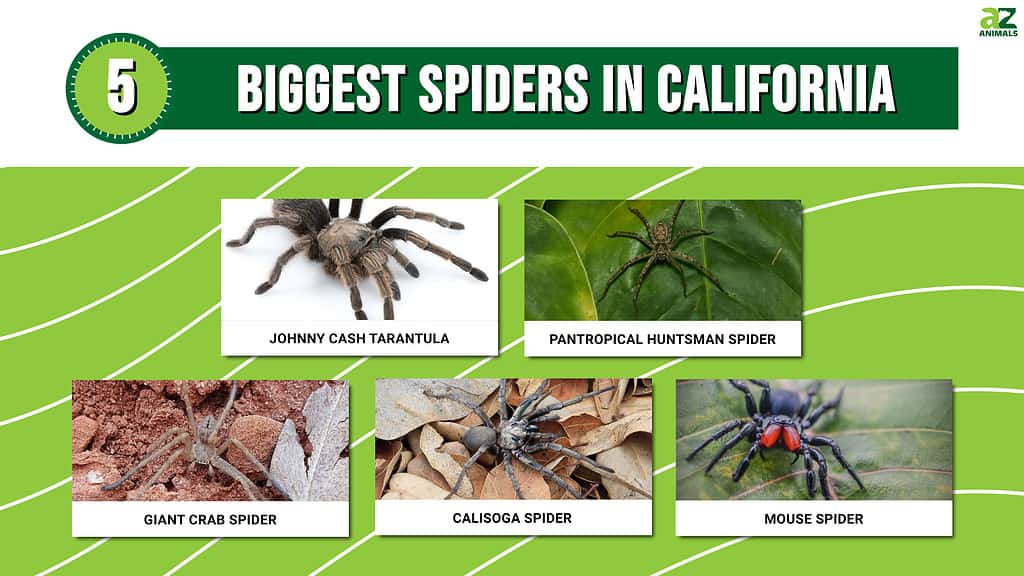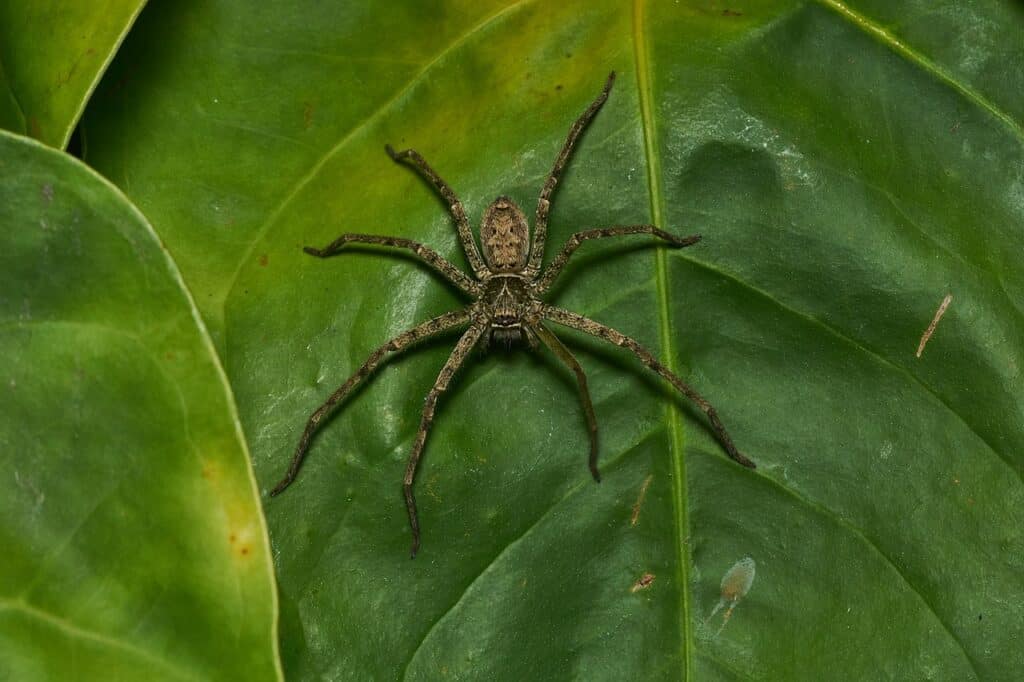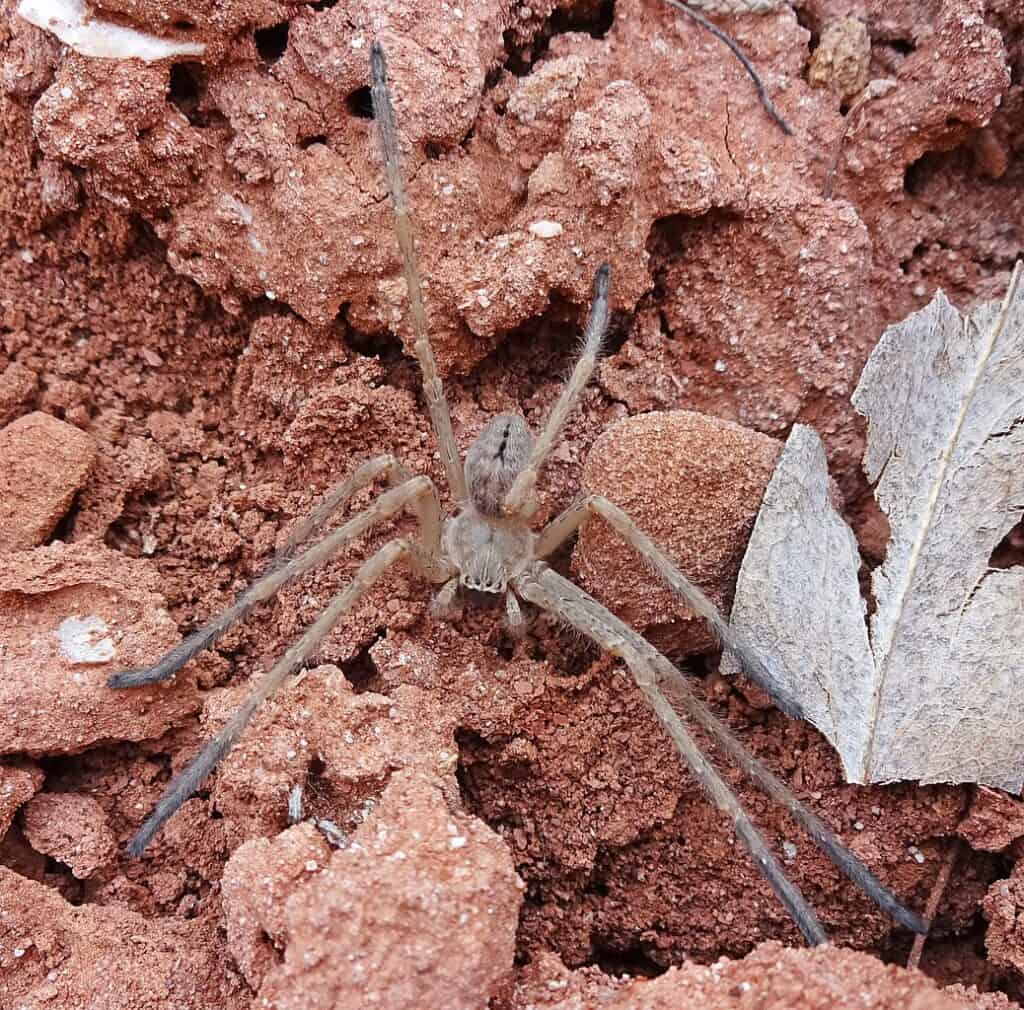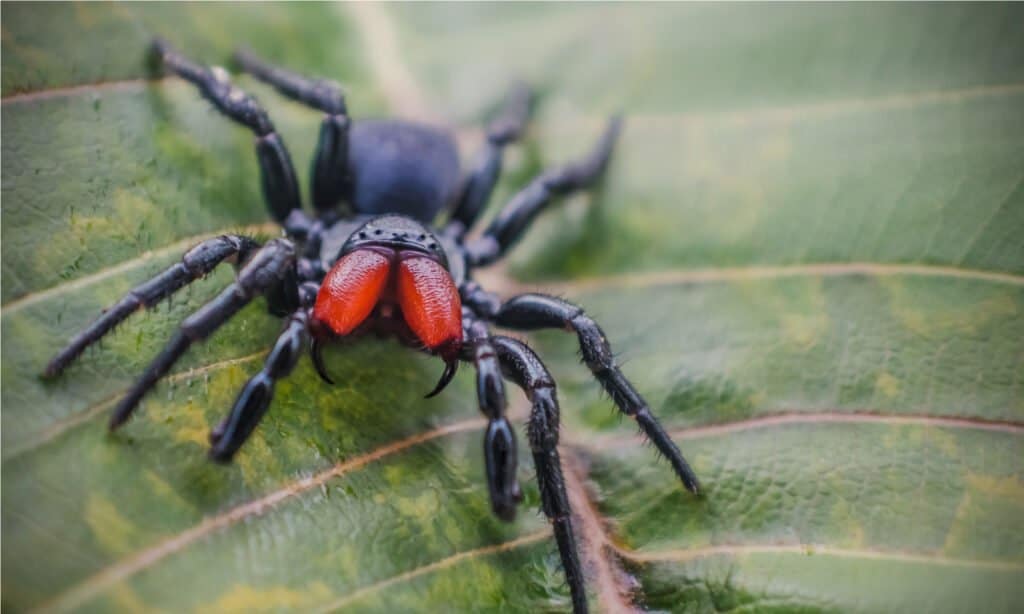California is home to about 66 different recognized spider species that vary in appearance and size. The state also has more species of spiders than any other state in the United States. California has a rich coastal landscape and natural diversity that makes it a desired place for many species of spiders to inhabit. Spiders, distributed throughout California, can be found in different environments, and they commonly take shelter near human civilization. If you are traveling to California or are interested in learning more about the largest spiders found in this state, we have compiled a list of the five biggest spiders in California for you. Here’s a preview:

Now, read on for more detail about these interesting California spiders.
1. Johnny Cash Tarantula – 6 inches

©Chris A. Hamilton, Brent E. Hendrixson, Jason E. Bond / CC BY 4.0
The newly discovered Aphonopelma johnnycashi is a medium-sized tarantula that grows up to 6 inches (15 cm) in size, with mature females being double the size of males. It rarely bites humans and only produces a mildly irritating venom if you do happen to get bitten.
This tarantula is distributed across the western foothills of the Sierra Nevada mountains and can be found throughout California. It was discovered in 2015 near the Folsom Prison located in California and got its unusual name “the Johnny Cash” tarantula from the “Folsom Prison Blues” song by the singer Johnny Cash.
Female tarantulas of this species have a brown, black, and tawny-colored body with a well-developed abdomen and are covered in fluffy hairs. The males have black bodies and rust-colored hairs on the lower half of their small abdomen and long legs. Both male and female Aphonopelma tarantulas shoot irritating hairs from their body as a defense mechanism.
2. Pantropical Huntsman Spider – 5 to 6 inches

The pantropical huntsman spider is a member of the crap spider family and reaches 5 to 6 inches in size
©© 2017 Jee & Rani Nature Photography / CC BY-SA 4.0 via Wikimedia Commons – License
The Pantropical huntsman spider (Heteropoda venatoria) is a member of the crab spider family and can be found in the subtropical and tropical regions in North America. It is commonly found in warm states such as California. They grow to roughly 5 to 6 inches (13-15 cm) with most of their size coming from their unusually long legs that frame their small light or dark brown bodies. Male Pantropical huntsman spiders are easy to identify with their slender dark bodies, whereas females are usually a more uniform brown color with thicker legs.
Unlike many other species of spider, the Pantropical huntsman does not produce any webbing and prefers to actively hunt their prey during the night, making them nocturnal predators. They are not known to be dangerous to humans, however, they can produce a painful bite that will result in swelling. They are very skittish toward humans and will often flee when they feel threatened.
3. Giant Crab Spider – 6 inches

The giant crab spider is an ambush predator which uses its speed to catch its prey
©Andrey Zharkikh from Salt Lake City, USA / CC BY 2.0, via Wikimedia Commons – License
The Olio’s giganteus or giant crab spider is a large spider that reaches an adult length of 6 inches (15 cm), and they are usually larger than other members of the crab spider family. They prefer the dry and warm climate that can be found in California, where they make excellent ambush predators who hunt their prey instead of creating a web.
These large and agile spiders are very fast and are often labeled as aggressive. However, they hardly interact with humans and will try to protect themselves if they feel threatened. The bite of a giant crab spider can be painful. Their venom may cause swelling and nausea which should wear off in a few hours without hospital treatment. The giant crab spiders’ legs and abdomen are covered in thick hairs and their brown coloration darkens towards their legs.
4. Calisoga Spider – 4 to 5 inches

Calisoga spiders are often known as false tarantulas and reach 4 to 5 inches long
©Marshal Hedin from San Diego, CC BY 2.0, via Wikimedia Commons – License
Commonly referred to as false tarantula, the calisoga spiders are part of the Memsiidae family. They are slightly smaller than most true species of tarantula, growing around 4 to 5 inches (10-13 cm) in size. One feature that sets the calisoga spider apart from true tarantulas in California is the lack of bristly hairs that cover a tarantula’s body.
The calisoga spider has a smooth and shiny brown body with a large abdomen. They hide in burrows with sandy and rocky terrain and prefer warm and humid climates. They are often sighted outdoors and are rarely found invading homes. However, their sightings go up around March when male calisoga spiders go on long walks in search of a mate.
5. Mouse Spider – 2 inches

Mouse spiders are often found indoors where they evade capture due to their quick and agile nature
©Brittany North/Shutterstock.com
The mouse spider (Scotophaeus blackwalli) can be found throughout Ireland, the United States, and the United Kingdom, with plenty of sightings in California. They are often found indoors and are very agile and fast for such a large spider. Mouse spiders can grow up to 2 inches (4 cm) in size, with females being larger than males.
The mouse spider is often confused with a trapdoor spider, which can be found in California. However, the mouse spider has a black body with a red mouth. Their body is shiny and covered in fine hairs that are the same color as their reddish-brown fangs and mouth.
The mouse spider has very large fangs that can make them look scary. Despite this, they rarely bite humans and only then if they are provoked. Most of their bites are dry and do not inject any venom that could harm humans during a dry taste.
Summary of the 5 Biggest Spiders in California
| Rank | Name | Length in Inches |
|---|---|---|
| 1. | Johnny Cash Tarantula | 6 |
| 2. | Pantropical Huntsman Spider | 5-6 |
| 3. | Giant Crab Spider | 6 |
| 4. | Calisoga Spider | 4-5 |
| 5. | Mouse Spider | 2 |
The photo featured at the top of this post is © Chris A. Hamilton, Brent E. Hendrixson, Jason E. Bond / CC BY 4.0 / Original
Thank you for reading! Have some feedback for us? Contact the AZ Animals editorial team.






